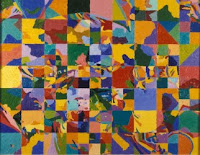This painting is certainly not one that I would choose to hang in my living room or any room in my house for that matter. I do not find it aesthetically pleasing however, I do find it is a very strong painting and I do like the texture of it. Everything about it is striking – the intense colours, the subject matter, the way in which it is painted. There is an almost grotesque air about the painting and when looking at it, there appear to be feelings of anger and possibly rage taken from the use of reds, yellows and oranges against the contrasting dark background. I don’t feel this painting relates to my own ideas about painting, the only qualities which I do admire in it are the thick texture and use of intense colours.
I feel that I’m always attracted to paintings which make use of vibrant colours specifically reds and purples, therefore I tend to use these colours in my own paintings. I also take interest in texture as I feel it adds a sense of depth and three-dimensional quality to paintings, making me want to touch them.
I had an idea that the painting was done on quite a large scale, this was taken from the assumed scale of the subject matter, quality of the brushstrokes, and how there doesn’t appear to be a lot of detail but rather areas of colour.
I think scale is an important factor in appreciating a painting – the larger the painting the more of an impact it creates. An extremely large painting can encapsulate you, surround you and really draw you into it which I feel you don’t get from a small painting. However, you can sometimes lose what the subject of the painting is when it is on such a grand scale.
Other examples of Soutine's work which I find more appealing:

The Man In Prayer

Glaieuls Rouges

Carcass of Beef










 The Man In Prayer
The Man In Prayer  Glaieuls Rouges
Glaieuls Rouges  Carcass of Beef
Carcass of Beef
 Judith Beheading Holofernes
Judith Beheading Holofernes  Self-portrait as Sick Bacchus
Self-portrait as Sick Bacchus  St.Matthew & the Angel
St.Matthew & the Angel .jpg) The Cardsharps (I Bari)
The Cardsharps (I Bari)  The Rest on the Flight to Egypt
The Rest on the Flight to Egypt